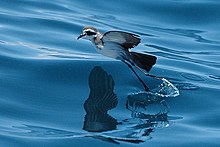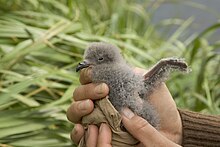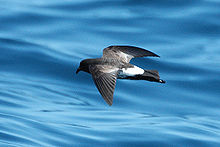Austral storm petrel
| Austral storm petrels | |
|---|---|

| |
| Wilson's storm petrel (Oceanites oceanicus) | |
| Scientific classification | |
| Domain: | Eukaryota |
| Kingdom: | Animalia |
| Phylum: | Chordata |
| Class: | Aves |
| Order: | Procellariiformes |
| Family: | Oceanitidae Forbes, 1881 |
| Genera | |
Austral storm petrels, or southern storm petrels, are seabirds in the family Oceanitidae, part of the order Procellariiformes. These smallest of seabirds feed on planktonic crustaceans and small fish picked from the surface, typically while hovering. Their flight is fluttering and sometimes bat-like.
Austral storm petrels have a
The family contains just ten species which are assigned to five different genera. Several species are threatened by human activities. The New Zealand storm petrel, was presumed extinct until rediscovered in 2003. The principal threats to storm petrels are introduced species, particularly mammals, in their breeding colonies; many storm petrels habitually nest on isolated mammal-free islands and are unable to cope with predators such as rats and feral cats.
Taxonomy
The family Oceanitidae was introduced in 1881 by the English zoologist
Up and down! - up and down!
From the base of the wave to the billow’s crown,
And amidst the flashing and feathery foam
The stormy petrel finds a home, -
A home, if such a place may be
For her who lives on the wide, wide sea.
O’er the deep! - o’er the deep!
Where the whale and the shark and the sword-fish sleep, -
Outflying the blast and the driving rain,
The petrel telleth her tale — in vain!
From "The Stormy Petrel" poem by
Morphology and flight
Austral storm petrels are the smallest of all the seabirds, ranging in size from 15–26 cm in length. Two body shapes occur in the family; the austral storm petrels have short wings, square tails, elongated skulls, and long legs. The legs of all storm petrels are proportionally longer than those of other Procellariiformes, but they are very weak and unable to support the bird's weight for more than a few steps.[2]
The plumage of the Oceanitidae is dark with white underparts (with the exception of Wilson's storm petrel) Onley and Scofield (2007) state that much published information is incorrect, and that photographs in the major seabird books and websites are frequently incorrectly ascribed as to species. They also consider that several national bird lists include species which have been incorrectly identified or have been accepted on inadequate evidence.[6]

Storm petrels use a variety of techniques to aid
Diet
The diet of many storm petrels species is poorly known owing to difficulties in researching; overall the family is thought to concentrate on crustaceans.[11] Small fish and molluscs are also taken by many species. Some species are known to be rather more specialised; the grey-backed storm petrel is known to concentrate on the larvae of goose barnacles.
Almost all species forage in the
Like many types of seabirds, storm petrels associate with other species of seabird and marine mammal species to help obtain food. They may benefit from the actions of diving predators such as seals and penguins, which push prey up towards the surface while hunting, allowing the surface-feeding storm petrels to reach them.[12]
Distribution and movements
The austral storm petrels typically breed found in the Southern Hemisphere, in contrast to the northern storm-petrel in the Northern Hemisphere.[11]
Several species of storm petrels undertake migrations after the breeding season. The most widely travelled migrant is Wilson's storm petrel, which after breeding in Antarctica and the subantarctic islands, regularly crosses the equator to the waters of the north Pacific and Atlantic Oceans. Some species, such as the grey-backed storm petrel, are thought to be essentially sedentary and do not undertake any migrations away from their breeding islands.
Breeding
Storm petrels nest

Storm petrels are
Threats and conservation

Several species of austral storm petrels are threatened by human activities.[20] The New Zealand storm petrel is listed as critically endangered, and was also considered extinct for many years, but was sighted again in 2003, though the population is likely to be very small. Storm petrels face the same threats as other seabirds; in particular, they are threatened by introduced species.
Species
The family contains ten species:[3]
| Image | Common name | Scientific name | Distribution |
|---|---|---|---|

|
Wilson's storm petrel | Oceanites oceanicus | South Shetland Islands |

|
Elliot's storm petrel | Oceanites gracilis | Galápagos Islands, Peru and Chile |
| Pincoya storm petrel | Oceanites pincoyae | Chile | |

|
Grey-backed storm petrel | Garrodia nereis | Antarctica, Argentina, Australia, Chile, Falkland Islands, French Southern Territories, New Zealand, Saint Helena, South Africa, and South Georgia and the South Sandwich Islands. |

|
White-faced storm petrel | Pelagodroma marina | Australia, New Zealand, Cape Verde Islands, Canary Islands and Savage Islands. |

|
White-bellied storm petrel | Fregetta grallaria | Angola, Argentina, Australia, Brazil, Chile, Ecuador, French Polynesia, French Southern Territories, Maldives, Namibia, New Zealand, Perú, Saint Helena, and South Africa. |

|
Black-bellied storm petrel or Gould's storm petrel | Fregetta tropica | Antarctica, Argentina, Australia, Bouvet Island, Brazil, Chile, Falkland Islands, French Polynesia, French Southern Territories, Madagascar, Mozambique, New Zealand, Oman, Peru, Saint Helena, São Tomé and Príncipe, Solomon Islands, South Africa, South Georgia and the South Sandwich Islands, Uruguay, and Vanuatu. |

|
New Zealand storm petrel | Fregetta maoriana | Coromandel Peninsula of New Zealand's North Island, |
| New Caledonian storm petrel | Fregetta lineata | New Caledonia | |
| Polynesian storm petrel (including white-throated storm petrel) | Nesofregetta fuliginosa | Chile, French Polynesia, Kiribati, New Caledonia, Vanuatu, possibly American Samoa |
References
- .
- ^ ISBN 84-87334-10-5
- ^ Rasmussen, Pamela, eds. (August 2022). "Petrels, albatrosses". IOC World Bird List Version 12.2. International Ornithologists' Union. Retrieved 12 November 2022.
- ^ A Library of Poetry and Song: Being Choice Selections from The Best Poets. With An Introduction by William Cullen Bryant, New York, J.B. Ford and Company, 1871, p. 354.
- PMID 9787440. Corrigendum
- ISBN 978-0-7136-4332-9
- ^ .
- JSTOR 4081455.
- .
- ISBN 0-679-45123-4
- ^ ISBN 0-19-850125-0
- ^ Harrison N.; Whitehouse M.; Heinemann D.; Prince P.; Hunt G.; Veit R. (1991). "Observations of Multispecies Seabird Flocks around South Georgia" (PDF). Auk. 108 (4): 801–810.
- doi:10.1139/z90-209.
- JSTOR 4512409.
- JSTOR 1370475.
- ^ Warham, J. (1976). "The Incidence, Function and ecological significance of petrel stomach oils" (PDF). Proceedings of the New Zealand Ecological Society. 24: 84–93. Archived from the original (PDF) on 2006-07-24.
- JSTOR 1369418.
- ISBN 0-8493-9882-7
- ^ Klimkiewicz, M. K. 2007. Longevity Records of North American Birds Archived 2011-05-19 at the Wayback Machine. Version 2007.1. Patuxent Wildlife Research Center. Bird Banding Laboratory. Laurel MD.
- ^ IUCN, 2006. Red List: Storm petrel Species Retrieved August 27, 2006.
External links
- Storm petrel videos on the Internet Bird Collection
